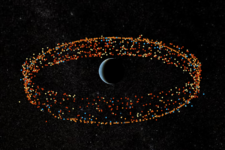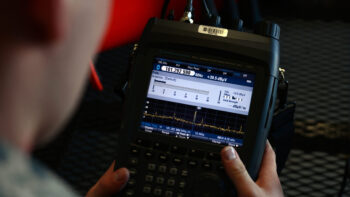
A model of the globe, based on NASA imagery. (Getty images)
Updated 4/7/2023 at 2:27 pm ET – The original version of this story stated that the UDL funding for fiscal 2024 was requested at $187 million based on government-provided figures. However, after publication, an official from \Air Force Public Affairs informed Breaking Defense that the number printed in the budget justification books was incorrect and provided a new number of $56 million. The story has been updated throughout.
WASHINGTON — Eyeing upgrades, the Space Force is asking Congress for almost twice the amount of money it wanted last year for its cloud-based data repository and, according to a top service official, will soon ask industry early next fiscal year to figure out how to do so.
Earlier this week Lisa Costa, chief technology and innovation officer for the Space Force, said that the service will be releasing a request for information in early fiscal 2024 for an “enhanced” version of its Unified Data Library (UDL).
The UDL, Space Systems Command’s cloud-based repository for space domain awareness, designed to take in data from multiple sources and turn it into one centralized, common picture. Such integration of data from disparate sources is a key goal of the Pentagon’s broader Joint All Domain Command and Control effort.
Speaking at the AFCEA Space Force IT Day on Tuesday, Costa said the UDL “was built based on the premise that we’re just going to process Space Force data…[but] it’s really the commercial data at scale that we need to combine with the Space Force data.” She added that it’s currently difficult to manage the UDL and that there’s a “backlog” of data waiting to be accessed.
Although Costa did not expand on what exactly an “enhanced” UDL would look like, and a spokesperson declined to elaborate specifically, budget documents outline some things the Space Force has planned for FY24 for the effort. And, according to an Air Force spokesperson, the Space Force wants $56 million for the UDL in FY24, compared to last year’s $29.5 million.
That funding will be used across a broad range of efforts linked to the UDL, like connecting additional Space Force sensors, “establishing bi-directional data sharing with coalition and allied partners, and increasing cloud hosting services” while also expanding its infrastructure “to maintain digital superiority, support an increased number of customers and operations across multiple security environments,” according to budget documents.
The budget documents incorrectly state an additional $131.4 is requested for the UDL, bringing the total request to $187.37 million. The spokesperson told Breaking Defense in a statement that the addition was mistakenly added and should’ve been added to another program. At this time, the budget documents have not been updated to reflect that mistake.
“The funding will not be used for the Unified Data Library but for expanding DoD purchase of commercial data as well as expanding the Sensor Communications Upgrade effort,” the spokesperson said in a statement. “This effort is geared towards increasing integration of Space Domain Awareness sensors with command and control capabilities, including one time sensor upgrades and communications network modernization in addition to sensor/UDL integration. The remaining $56M is directly for the UDL project.”
The service will also on-board new data sets to the library and expand its “defensive cyber operations capabilities,” budget documents say, and connect the UDL to more than 20 “additional Space Surveillance Network (SSN) and non-traditional SDA sensors with modernized interfaces and transport options,” among other things.
“As data ingress and egress grow, a portion of the funds will cover associated cloudhosting costs, data service development, security, system administration, data on boarding, data as a service platform retention, processing, and normalization,” the budget documents say. The funding will also be used by the Space Force to “analyze space warfighting data across the global space enterprise, as well as for Space Force related exercise support, cross-domain solution services and integration of the legacy communications architecture with the UDL.”






















